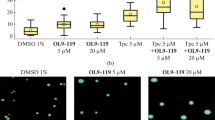Abstract
Inhibition of DNA topoisomerase II with vepesid induced structural and functional reorganization of chromatin in meiotically dividing spermatocytes I, which later led to the block of their differentiation and long-lasting disorders in spermatogenesis. Vepesid induced decondensation of spermatocyte I chromatin, block of desynapsis, and elongation of lateral elements of spermatocyte autosome synaptonemal complexes during late pachytene and diplotene of meiosis. This confirms the involvement of type II DNA topoisomerase in chromatin condensation and homologous chromosome desynapsis at the stage of diplotene and the role of this enzyme in structural organization of the synaptonemal complex. Vepesid induced the formation of dichotomy and breaks of the pericentromer regions of subelements of lateral elements of the autosomal synaptonemal complexes; the number of cells with associations of axial elements of sex chromosomes with autosomal synaptonemal complexes increased, univalents of autosomes and sex chromosomes appeared. Mesna, a modifier of toxic effects of antitumor drugs, had no toxic effect on spermatogenic cells. Mesna reduced the lethal effect of vepesid during combined treatment, but did not ensure long-term protection of spermatogenesis.
Similar content being viewed by others
REFERENCES
T. A. Bogush, E. Yu. Koldaeva, G. B. Smirnova, et al., Byull. Eksp. Biol. Med., 132,No. 9, 301-305 (2001).
E. D. Gol'dberg, T. G. Borovskaya, E. A. Timina, et al., Ibid., 124,No. 2, 645-648 (1997).
T. V. Sukhacheva, O. L. Kolomiets, and E. F. Loseva, Ibid., 125,No. 1, 84-88 (1998).
J. L. Chen and F. J. Longo, Mol. Reprod. Dev., 45,No. 1, 61-71 (1996).
J. Cobb, M. Miyaike, A. Kikuchi, and M. A. Handel, Chromosoma, 108, 412-425 (1999).
J. Forejt, Serono Clin. Colloq. Reprod., 3, 135-151 (1982).
M. A. Handel and R. K. Reddy, Biol. Reprod., 52, 192 (1995).
M. Kallio and J. Lдhdetie, Mutagenesis, 11,No. 5, 435-443 (1996).
J. Lдhdetie, A. Keiski, A. Suutari, and J. Toppari, Environ. Mol. Mutagen., 24,No. 3, 192-202 (1994).
M. Links and C. Lewis, Drugs, 57,No. 3, 293-308 (1999).
J. del Mazo and L. Gil-Alberdi, Cytogenet. Cell Genet., 41, 219-224 (1986).
P. B. Moens and W. C. Earnshaw, Chromosoma, 98, 317-322 (1989).
J. Navarro, F. Vidal, M. Quitart, et al., Human Genet., 59, 419-423 (1981).
J. B. Rattner, M. J. Hendzel, C. S. Furbee, et al., J. Cell Biol., 134,No. 5, 1097-1107 (1996).
D. Rose and C. Holm, Mol. Cell. Biol., 13,No. 6, 3445-3455 (1993).
Author information
Authors and Affiliations
Rights and permissions
About this article
Cite this article
Sukhacheva, T.V., Bogush, T.A. & Kolomiets, O.L. Destructive Effect of DNA Topoisomerase II Inhibitor Vepesid on Mouse Spermatogenesis. Bulletin of Experimental Biology and Medicine 135, 464–469 (2003). https://doi.org/10.1023/A:1024919510096
Issue Date:
DOI: https://doi.org/10.1023/A:1024919510096



